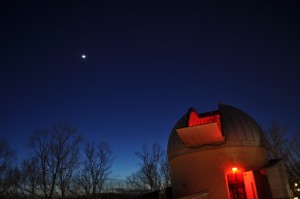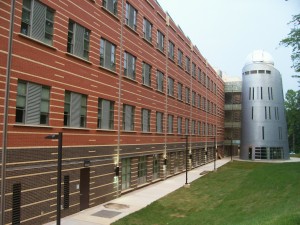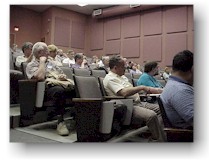Sunday December 9, 2012 7:00 pm to 9:00 pm
Guest Speaker: Astronaut Tom Jones
Dr. Thomas D. Jones is a scientist, author, pilot, and former NASA astronaut. He holds a doctorate in planetary sciences from the University of Arizona, and in more than eleven years with NASA, flew on four space shuttle missions to Earth orbit. On his last flight, Dr. Jones led three spacewalks to install the centerpiece of the International Space Station, the American Destiny laboratory. He has spent fifty-three days working and living in space.
Dr. Jones will speak on the Science of Planetology.
Our next speaker is Gideon Bass and he will be speaking on Kepler Studies of Low-Mass Eclipsing
Summary of Upcoming Lecture

Dr. Michael Summers and Implications of Finding Alien Life in Research Hall Science Showcase. 1st talk at 6PM, same talk at 6:45PM, observing starts at 6;30PM until 8PM.
Campus Map – The George Mason University Observatory at the Fairfax Campus building Research Hall formerly known as Research I.

Manuela Dal Forno and The World of Lichens – Research Hall Science Showcase (especially recommended for kids). 1st talk at 6PM (weather permitting), same talk at 6:45PM (weather permitting), observing starts at 6:30PM until 8PM (weather permitting).
Campus Map – The George Mason University Observatory at the Fairfax Campus building Research Hall formerly known as Research I.
Tuesday 26 February 2013: This date IF AND ONLY IF 19 February 2013 canceled due to weather. 1st talk at 6PM, same talk at 6:45PM, observing starts at 6:30PM until 8PM.

THIS EVENT HAS BEEN CANCELLED DUE TO IMPENDING WEATHER
1st talk at 6PM (weather permitting), same talk at 6:45PM (weather permitting), observing starts at 6:30PM until 8PM (weather permitting).
Campus Map – The George Mason University Observatory at the Fairfax Campus building Research Hall formerly known as Research I.
Our next speaker is Andrea Jones and she will be speaking on Mars Exploration Missions and Future

1st talk at 7PM, same talk at 7:45PM, observing starts at 7:30PM until 9PM.
Campus Map – The George Mason University Observatory at the Fairfax Campus building Research Hall formerly known as Research I.
Tuesday 26 March 2013: This date IF AND ONLY IF 19 March 2013 canceled due to weather. 1st talk at 7PM, same talk at 7:45PM, observing starts at 7:30PM until 9PM.

1st talk at 7PM, same talk at 7:45PM, observing starts at 7:30PM until 9PM.
Campus Map – The George Mason University Observatory at the Fairfax Campus building Research Hall formerly known as Research I.
Tuesday 9 April 2013: This date IF AND ONLY IF 2 April 2013 canceled due to weather. 1st talk at 7PM, same talk at 7:45PM, observing starts at 7:30PM until 9PM.
Guest Speaker: Dr. Gianluca Masi
Next 14 April, starting at 23:15 UT, the Northern Virginia Astronomy Club (NOVAC) will offer you a unique chance to explore cosmic landscapes from the comfort of your chair.
Thanks to a joint collaboration between NOVAC and the Virtual Telescope Project (VT)in Italy (www.virtualtelescope.eu), a powerful telescope in Italy will be capturing in real time images of the most beautiful cosmic gems and will share the view with all those connected from all around the planet.
All this with the live commentary of the astrophysicist Gianluca Masi, PhD, founder and scientific director of the Virtual Telescope Project, who will be available on the event chat for questions and comments.
We will surf the northern Spring skies, spying beautiful, distant galaxies like Messier 51, Messier 100, NGC 4565 and so on, also spying dying stars, exploding supernovae millions and millions of light years away. On our way back home, we will visit planet Saturn and its elegant, amazing rings. Of course, participants can suggest their own preferred destinations via chat, adding interactivity to the trip.
NOVAC and VT will open the online event to all, for free: to join, you just need to access, at the event date and time, the page:www.astrowebtv.org
In case of cloudy weather at the observatory, backup images will be used.
This event is part of the Global Astronomy Month 2013.


